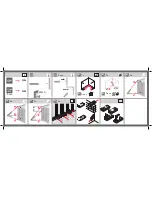
Windowing improves the dynamic range of a time domain measurement by
the
frequency domain data prior to converting it to the time domain, producing an impulse
stimulus that has lower sidelobes This makes it much easier to see time domain responses that
are very different in magnitude. The
reduction is achieved, however, at the expense of
increased impulse width. The effect of windowing on the step stimulus (low pass mode only) is
a reduction of overshoot and ringing at the expense of increased rise time.
the selection of three window types (see
6-10. Impulse Width,
Level, and Windowing Values
window
Low
Span
-21
Span
Normal
Span
span
Maximum
Span
span
The
mode simulates an impulse
impulse width is twice
of low pass
impulse width. The
impulse
levels are the same as low pass impulse
levels.
Choose one of the three window shapes listed in
6-10. Or you can use the knob to select
any windowing pulse width (or rise time for a step stimulus) between the
values. The
time domain stimulus
levels depend only on the window selected.
is essentially no window. Consequently, it gives the highest
sidelobes.
(the preset mode) gives reduced sidelobes and is the mode
most often used.
window gives the minimum sidelobes, providing the
greatest dynamic range.
.
remembers a
step
rise time) different from the standard window values.
A window is activated only for viewing a time domain response, and does not affect a
displayed frequency domain response.
6-72 shows the typical effects of windowing on
the time domain response of a short circuit reflection measurement.
Appliwtion and Operation Concepts 6-131
Summary of Contents for 8719D
Page 153: ...M a k i n g M i x e r M e a s u r e m e n t s O p t i o n 089 Only1 3 19 ...
Page 189: ... 4 18 Printing Plotting and Saving Measurement Results ...
Page 338: ... Figure 6 41 Open Circuit Rmnination 6 64 Application and Operation Concepts ...
Page 467: ......
Page 468: ...8 2 Menu M a p s ...
Page 469: ......
Page 470: ...84 Menu Maps ...
Page 473: ...Menu Maps 8 7 ...
Page 475: ...Menu Maps a 9 ...
Page 476: ...I 9 10 MenuYaps ...
Page 477: ...Menu Maps 9 11 ...
Page 478: ...MlFl EF FEFEFEII TE 9 l 2 Menu Maps ...
Page 479: ......
Page 480: ...8 14 Menu Maps ...
Page 481: ...r c 1 pb6le Menu Maps 8 l 6 ...
Page 537: ...6 66 Key Definitions ...
Page 556: ... Ihble 9 2 Softkey Locations continued Softkey Front Panel Access Key Key Definitions 9 75 ...
Page 557: ...9 76 Key Definitions ...
Page 558: ...lhble 9 2 Softkey Locations continued Softkey Front Panel Access Key Key Definitions D 77 ...
Page 559: ...Ihble 9 2 Softkey Locations continued Softkey Key Definitions ...
Page 560: ... Jhble 9 2 Softkey Locations continued Key Definitions a 78 ...
Page 561: ...able 9 2 Softkey Locations continued 8 80 Key Definitions ...
Page 563: ... ble 9 2 Softkey Locations continued 842 Definitions ...
Page 565: ...able 9 2 Softkey Locations continued Softkey Front Panel Access Key 8 64 Key Definitions ...
Page 566: ... Ihble 9 2 Softkey Locations continued Key Definitions 8 85 ...
Page 567: ...Kay Definitions ...
Page 568: ... lbble 9 2 Softkey Locations continued Key Definitions 8 87 ...
Page 569: ...lhble 9 2 Softkey Locations continued Softkey Front Panel Access Key 8 88 KeyDefinitions ...
Page 570: ... able 9 2 Softkey Locations continued Softkey Front Panel Access Key Key Definitions 8 88 ...
Page 571: ...840 Key Definitions Ihble 9 2 Softkey Locations continued Softkey Front Panel Access Key ...
Page 572: ...able 9 2 Softkey Locations continued Softkey Front Panel Key Definitions 8 81 ...
Page 573: ... Ihble 9 2 Softkey Locations continued Softkey Front Panel Access Key 842 Key Definitions ...
















































